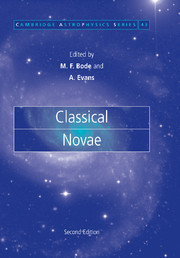Book contents
- Frontmatter
- Contents
- List of contributors
- Preface to the first edition
- Preface to the second edition
- List of symbols
- 1 Novae: an historical perspective
- 2 Properties of novae: an overview
- 3 The evolution of nova-producing binary stars
- 4 Thermonuclear processes
- 5 Nova atmospheres and winds
- 6 Observational mysteries and theoretical challenges for abundance studies
- 7 Radio emission from novae
- 8 Infrared studies of classical novae
- 9 Optical and ultraviolet evolution
- 10 X-ray emission from classical novae in outburst
- 11 Gamma-rays from classical novae
- 12 Resolved nebular remnants
- 13 Dust and molecules in nova environments
- 14 Extragalactic novae
- Object index
- Subject index
8 - Infrared studies of classical novae
Published online by Cambridge University Press: 10 October 2009
- Frontmatter
- Contents
- List of contributors
- Preface to the first edition
- Preface to the second edition
- List of symbols
- 1 Novae: an historical perspective
- 2 Properties of novae: an overview
- 3 The evolution of nova-producing binary stars
- 4 Thermonuclear processes
- 5 Nova atmospheres and winds
- 6 Observational mysteries and theoretical challenges for abundance studies
- 7 Radio emission from novae
- 8 Infrared studies of classical novae
- 9 Optical and ultraviolet evolution
- 10 X-ray emission from classical novae in outburst
- 11 Gamma-rays from classical novae
- 12 Resolved nebular remnants
- 13 Dust and molecules in nova environments
- 14 Extragalactic novae
- Object index
- Subject index
Summary
Introduction
Infrared observations have contributed substantially to our understanding of how classical novae participate in the chemical evolution of the Galaxy. We describe how infrared observations, combined with optical measurements, can provide quantitative measurements of the primary physical parameters that characterize the outburst, the abundances of elements that are present in the ejecta, and the properties of the grains that condense in the nova wind. We summarize recent evidence that novae are capable of producing large over-abundances of some metals and that they are potential sources of ‘stardust’ similar to the small grains that populate comet comae.
Nova explosions in the context of Galactic chemical evolution
Galactic classical novae take part in a cycle of Galactic chemical evolution in which grains and gas in the ejecta of evolved stars enrich the metal abundance of the Galactic ‘ecosystem’ (see Figure 8.1). Metals produced in stars during post-main-sequence (PMS) nucleosynthesis are ejected into the interstellar medium (ISM) by stellar winds and explosive events. Some of these metals remain in the gas phase, but others can condense to form grains. In the ISM, the gas and grains may become a component of the giant molecular clouds that give birth to new generations of young stars and planetary systems during the star formation process.
- Type
- Chapter
- Information
- Classical Novae , pp. 167 - 193Publisher: Cambridge University PressPrint publication year: 2008
- 25
- Cited by



